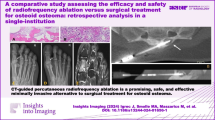Abstract
Osteoid osteoma (OO) is a benign tumour that can cause severe pain and functional limitation to children and young adults; the treatment of choice is image-guided ablation. Due to the very small size of the lesion, detection and accurate needle placement may be challenging. Computed tomography (CT) offers very detailed imaging of the skeleton and is the modality of choice for the detection of small OO and for ablation guidance. Nevertheless, CT-guided positioning of the ablation applicator is linked to significant radiation exposure, particularly for the paediatric population. This case describes the successful use of a novel CT-based navigation system that offers the possibility of accurate ablation with only minimal radiation exposure in a paediatric patient.






Similar content being viewed by others
References
Davidson RS, Mahboubi S, Heyman S, Drummond DS. Nondiaphyseal osteoid osteomas in the pediatric patient. Clin Orthop Relat Res. 1989;243:230–4.
Herring JA. Tachdjian’s pediatric orthopaedics. 3rd ed. Philadelphia, London, New York, St. Louis, Sydney, Toronto: W B.
Rimondi E, Bianchi G, Malaguti MC, et al. Radiofrequency thermoablation of primary non-spinal osteoid osteoma: optimization of the procedure. Eur Radiol. 2005;15:1393–9.
Pinto CH, Taminiau AHM, Vanderschueren GM, et al. Technical considerations in CT-guided radiofrequency thermal ablation of osteoid osteoma: tricks of the trade. AJR Am J Roentgenol. 2002;179:1633–42.
Rosenthal DI, Hornicek FJ, Torriani M, Gebhardt MC, Mankin HJ. Osteoid osteoma: percutaneous treatment with radiofrequency energy. Radiology. 2003;229:171–5.
Cantwell CP, O’Byrne J, Eustace S. Radiofrequency ablation of osteoid osteoma with cooled probes and impedance-control energy delivery. AJR Am J Roentgenol. 2006;186:S244–8.
Martel J, Buenoa A, Ortiz E. Percutaneous radiofrequency treatment of osteoid osteoma using cool-tip electrodes. Eur Radiol. 2005;56:403–8.
Woertler K, Vestring T, Boettner F, Winkelmann W, Heindel W, Lindner N. Osteoid osteoma: CT-guided percutaneous radiofrequency ablation and follow-up in 47 patients. J Vasc Interv Radiol. 2001;12(6):717–22.
Cantwell CP, Kenny P, Eustace S. Low radiation dose CT technique for guidance of radiofrequency ablation of osteoid osteoma. Clin Radiol. 2008;63(4):449–52.
Cheng EY, Naranje SM, Ritenour ER. Radiation dosimetry of intraoperative cone-beam compared with conventional CT for radiofrequency ablation of osteoid osteoma. J Bone Joint Surg Am. 2014;96(9):735–42. doi:10.2106/JBJS.M.00874.
Busser WM, Hoogeveen YL, Veth RP, et al. Percutaneous radiofrequency ablation of osteoid osteomas with use of real-time needle guidance for accurate needle placement: a pilot study. Cardiovasc Intervent Radiol. 2011;34(1):180–3.
European Guidelines for Multislice Computed Tomography, http://www.msct.info/CT_Quality_Criteria.htm.
Filippiadis D, Gkizas C, Kostantos C, et al. Percutaneous biopsy and radiofrequency ablation of osteoid osteoma with excess reactive new bone formation and cortical thickening using a battery-powered drill for access: a technical note. Cardiovasc Intervent Radiol. 2016;39(10):1499–505.
Schnapauff D, Streitparth F, Jöhrens K, et al. CT-guided radiofrequency ablation of osteoid osteoma using a novel battery-powered drill. Skeletal Radiol. 2015;44(5):695–701. doi:10.1007/s00256-014-2029-9.
Beyer LP, Pregler B, Nießen C, et al. Stereotactically-navigated percutaneous Iireversible electroporation (IRE) compared to conventional IRE: a prospective trial. Peer J. 2016;4:e2277.
Author information
Authors and Affiliations
Corresponding author
Ethics declarations
Conflict of interest
IRB approval was obtained for retrospective review of the cases where the specific navigation system was used in the department.
The navigation system is owned by the Department of Radiology and is used in everyday clinical practice. None of the authors has any conflicts of interest with the manufacturer.
Author 1: None
Author 2: None
Author 3: None
Author 4: None
Rights and permissions
About this article
Cite this article
Krokidis, M., Tappero, C., Bogdanovic, D. et al. Computed tomography guided navigation assisted percutaneous ablation of osteoid osteoma in a 7-year-old patient: the low dose approach. Skeletal Radiol 46, 989–993 (2017). https://doi.org/10.1007/s00256-017-2620-y
Received:
Revised:
Accepted:
Published:
Issue Date:
DOI: https://doi.org/10.1007/s00256-017-2620-y




